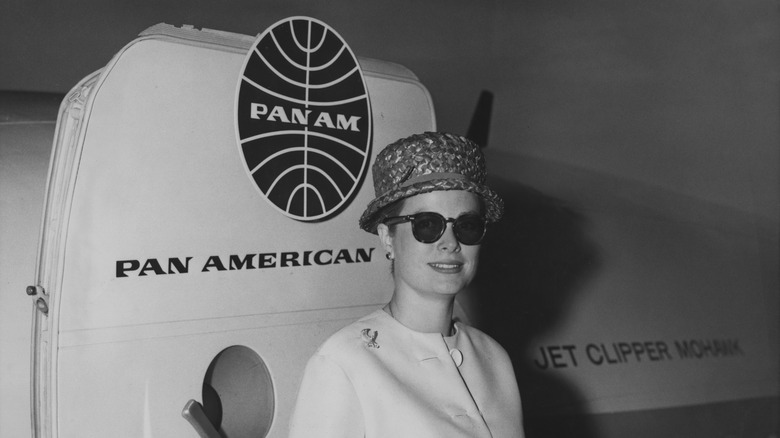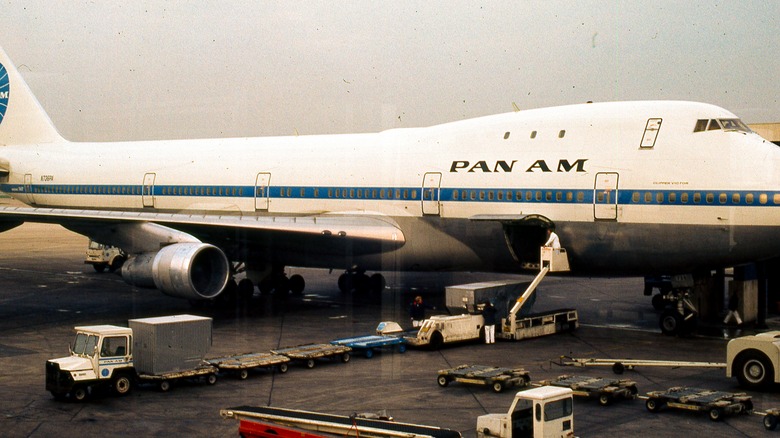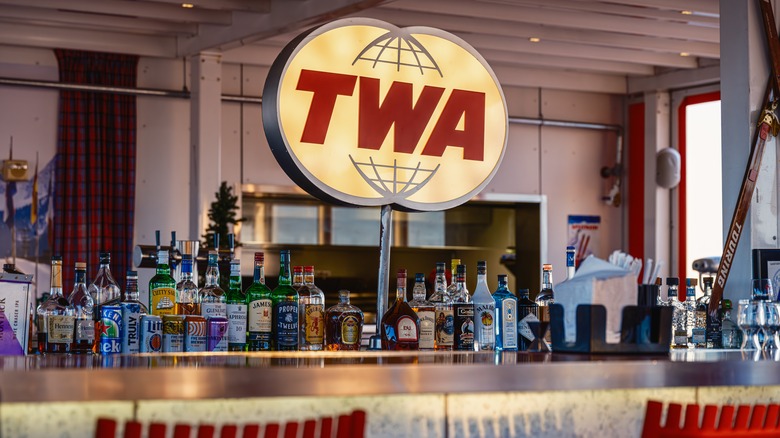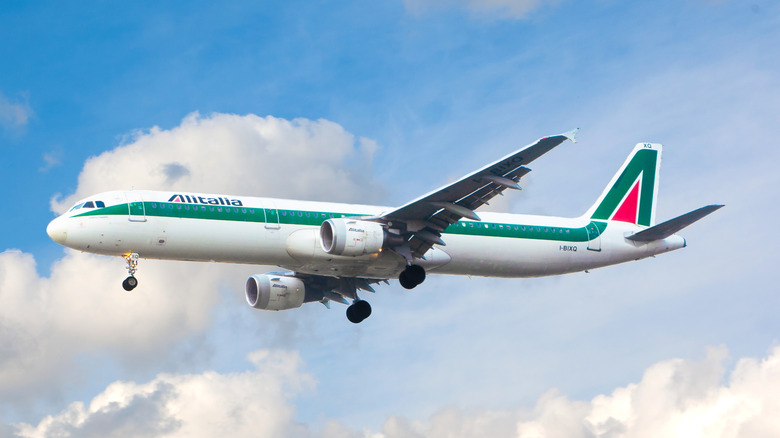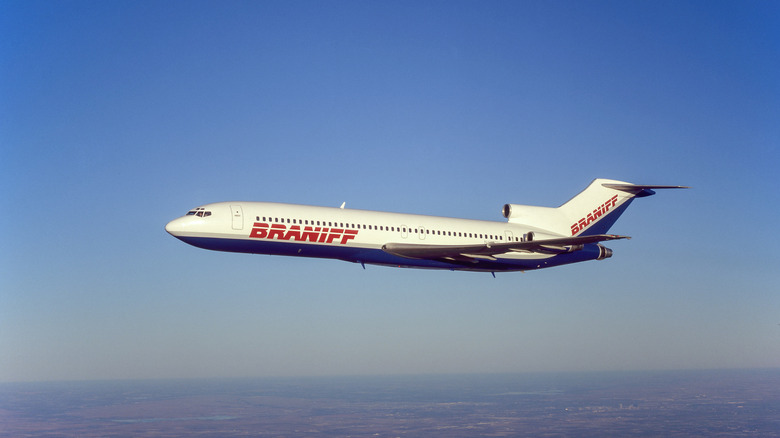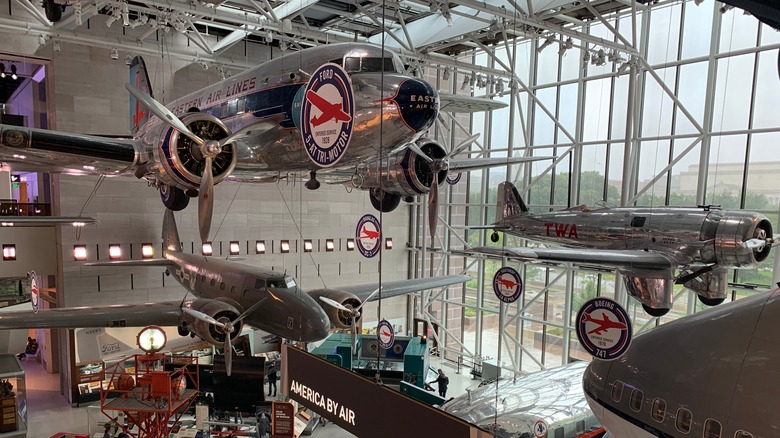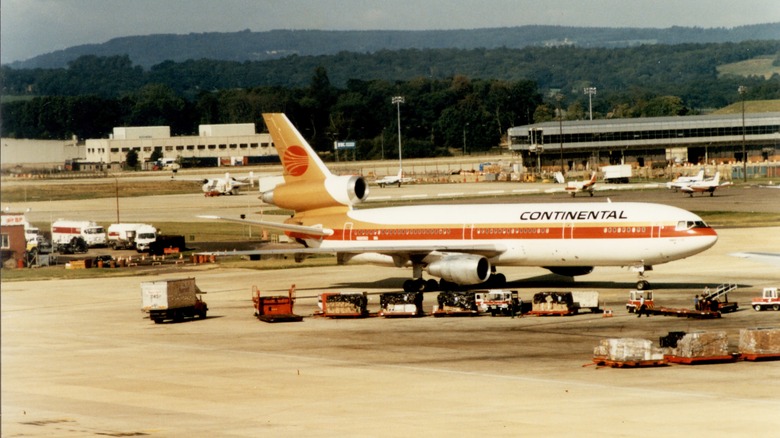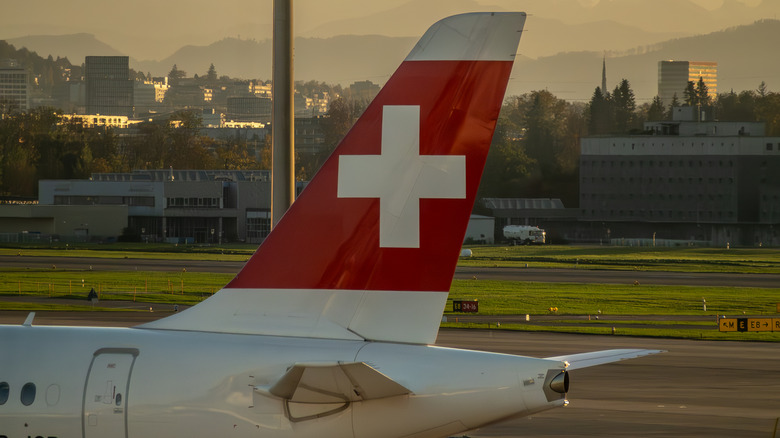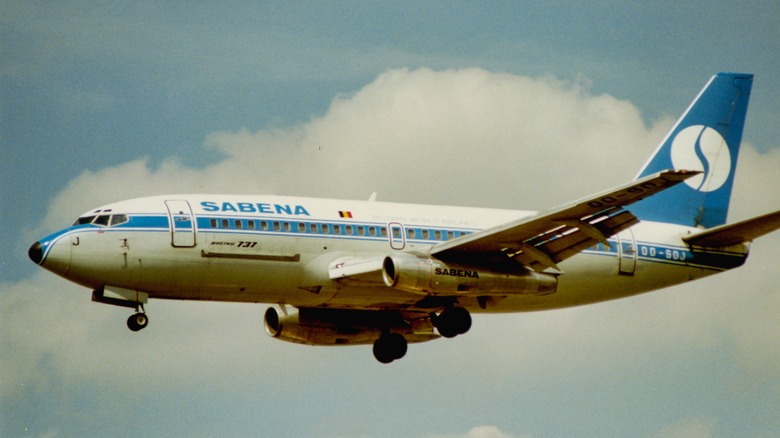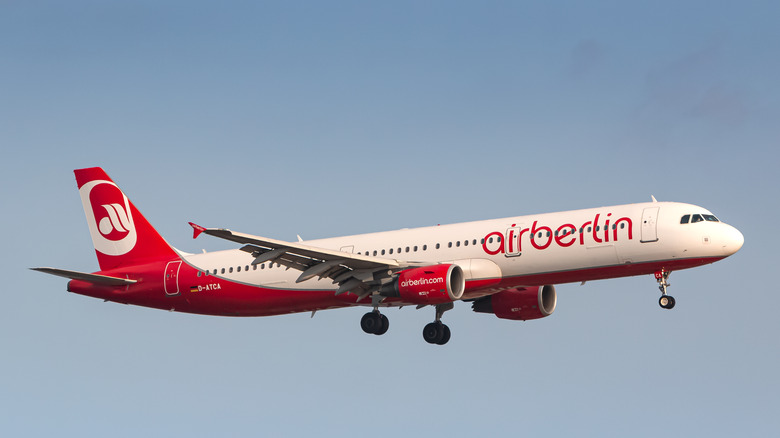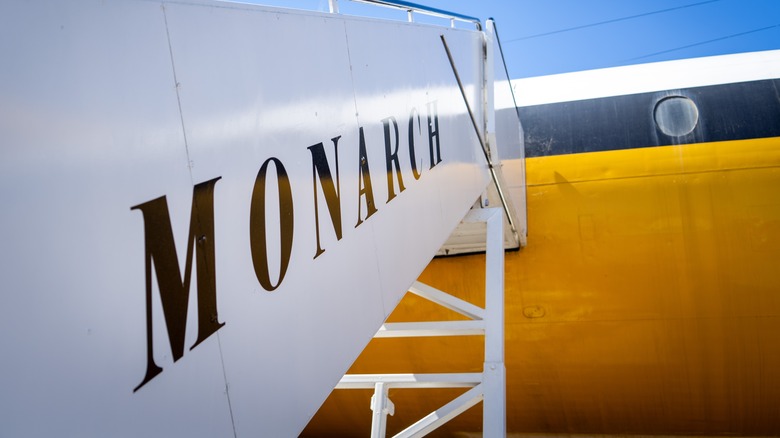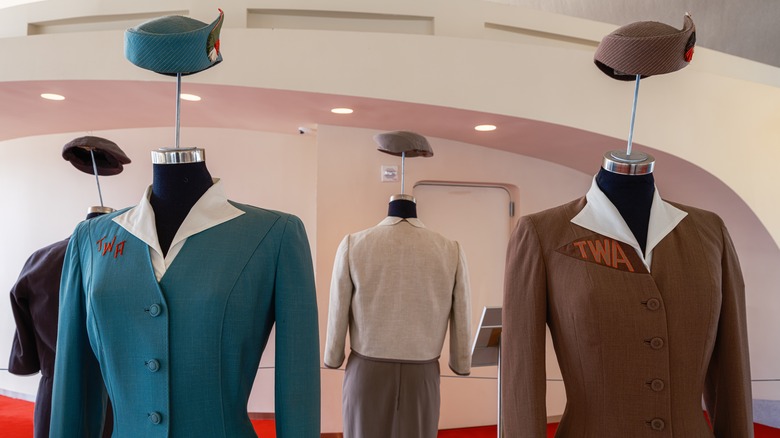10 Airlines That Went Bankrupt And Never Recovered
There was a time when air travel was the ultimate luxury. It was a symbol of glamour, sophistication, and adventure. Passengers dressed in their finest clothes, champagne flowed freely, and flight attendants embodied chicness itself. Airlines were cultural icons, defining what it meant to travel well. Sadly, as the decades passed, the skies became far less forgiving — and far less glamorous. Wars, economic downturns, the deregulation of the airline industry in 1978, and rapid growth in competition transformed once-luxurious brands into nothing more than memories from days gone by (and a few scenes of Don Draper in "Mad Men").
The rise of budget carriers and the increasing pressure to cut costs transformed air travel from an indulgence into something that resembles an assembly line. Even the most successfully branded airlines, like those that represented national pride or jet-set sophistication, sometimes could not survive mounting debt and evolving consumer expectations. In this article, we'll revisit 10 defunct airlines that once defined the golden age of flight, from icons of mid-century style to ambitious carriers who just couldn't make a go of it financially. Each of these bygone airlines tells a story of innovation, glamour, and loss, serving as something of a time capsule to the days when flying wasn't merely about getting from place to place. And if you want to pretend you're a mid-century jetsetter for a moment, check out the airlines that make it easy to save money while booking first-class seats.
Pan American World Airways (Pan Am)
No airline captures the golden age of air travel quite like Pan American World Airways. From the birth of the brand in 1927 until its final flight in 1991, Pan Am unequivocally defined what it meant to fly in style. The U.S.'s first international carrier, Pan Am, became a global symbol of American style and ingenuity. During the jet age of the 1950s and 1960s, Pan Am pioneered innovations that shaped modern aviation. It changed air travel forever when it brought jet technology to commercial aviation with its Boeing 707 fleet. It also offered in-flight fine dining and connected the world like never before. While today's flight attendants sometimes spill secrets airlines don't want you to know, Pan Am was all about mystique. Its glamorous flight attendants became cultural icons, and the Pan Am name was synonymous with the excitement of traveling abroad to experience everything the world has to offer.
Sadly, the very ambition that made Pan Am great catalyzed its eventual downfall. Overexpansion, corporate hubris, rising fuel costs, and intense competition as air travel became more accessible strained the airline's already shaky financial situation. Then, the 1988 Lockerbie bombing of Flight 103 was the final nail in its coffin. The incident horrifically killed 270 people, devastating the company both fiscally and reputationally. Just three years later, Pan Am ceased operations. Though it's been gone for over three decades now, Pan Am's legacy endures. Its legendary blue branding and belief that travel should be a true experience, not just something you do, continue to inspire everything from television series to retro merchandise.
Trans World Airlines (TWA)
For much of the 20th century, Trans World Airlines, better known as TWA, was one of the most glamorous names in the sky. A fierce rival to Pan Am, TWA also defined the jet-set era of midcentury America, when air travel was just about the most stylish thing you could do. The airline cultivated close ties with Hollywood, transporting stars between the East Coast and West Coast, and all over the world. Unsurprisingly, given its Tinseltown connections, the brand was even the first to introduce in-flight movies. In short, flying TWA meant being part of something dazzlingly modern. Founded in 1930 and taken over by eccentric billionaire and aviation enthusiast Howard Hughes less than a decade later, TWA became known for its cutting-edge aircraft and impeccable service. In 1990, the company even attempted to buy its struggling competitor, Pan Am, solidifying its status as an airline powerhouse.
However, the glitz and glam were largely a smokescreen, and turbulence brewed. Behind the sparkle of TWA's marketing, years of corporate mismanagement, financial instability, and three bankruptcies ultimately grounded the airline. By 2001, the company was fully absorbed by American Airlines, marking the end of an era in flight. Today, TWA's legacy lives on at the stunning TWA Hotel at New York's John F. Kennedy International Airport (JFK). This impeccably restored midcentury terminal doubles as a luxury hotel and a love letter to aviation's golden age. With its Eero Saarinen architecture, uniforms created by actual TWA designer Stan Herman, and a cocktail lounge built inside of a vintage plane, the hotel keeps the TWA spirit alive in the 21st century.
Alitalia
Insofar as Pan Am and TWA defined aviation glamour in the United States, Alitalia did the same for Italy. After taking its first flight in 1947, the airline became a national symbol of the "la dolce vita" lifestyle, transporting everyone from film stars to diplomats with distinctly Italian style. Every detail, including espresso service at 30,000 feet and duty-free silk scarves, perfumes, and more, reflected Italy's reputation for living the good life. The flight crew's uniforms alone told a story of Italian style. In the 1950s, the airline collaborated with Sorelle Fontana, one of Italy's most iconic design houses, to bring couture into the cabin. Later, in the 1990s, Giorgio Armani reimagined the look, taking his signature suiting from Milan's runways to airport runways around the world. "It was all about style," one former stewardess reminisced on the Hidden Treasures of Italy blog.
Yet underneath the glamour, things were not as they seemed. Mounting debt, political interference, and years of mismanagement left Alitalia struggling to compete during a modern era in which deregulated, low-cost travel still reigns supreme. The September 11 attacks, which largely halted global travel for a time, accelerated the Italian brand's decline. Despite repeated bailouts, Alitalia announced it would cease ticket sales in 2021. Its successor, ITA Airways, carries the torch for the "winged arrow," but it will never quite capture the golden age allure at which Alitalia once excelled.
Braniff International Airways
Arguably, no other airline captured the bold, colorful spirit of the 1960s like Braniff International Airways. While the idea of branding as an art form was still in its infancy on Madison Avenue, Braniff turned air travel into a fashion statement with planes that featured modern interiors, avant-garde advertising, and a super stylish flight crew. Under the creative direction of designer Alexander Girard, Braniff's fleet became instantly recognizable. Each aircraft was painted in fluorescent colors as part of the "End of the Plain Plane" campaign. Inside, every detail was curated with midcentury modern perfection. The airline even tapped Emilio Pucci to design its flight attendant uniforms, which featured the Italian designer's signature bold prints, go-go boots, and, perhaps most uniquely, stylized space helmets.
However, Braniff's ambition ultimately outpaced its financial stability by a long shot. Lavish spending on design and unrealistic expansion, combined with rising fuel costs and deregulation, left the brand's fiscal situation in shambles. Despite being the ninth-largest U.S. airline at the time, Braniff filed for bankruptcy in May 1982, permanently grounding its famously colorful fleet. Today, Braniff International offers licensing to promote and preserve the famous airline's bold legacy. Braniff remains a pop culture icon and will always have a place in flight lore as the brand that dared to become the "It Girl" of aviation.
Eastern Air Lines
Though it began as an airmail carrier with a government contract in 1927, Eastern Air Lines evolved into one of America's most powerful commercial airlines. It was one of the "Big Four" that dominated the skies during aviation's golden age, alongside TWA, United, and American. The brand's bread and butter was operating major routes along the East Coast and into the Caribbean. Under the leadership of legendary World War I flying ace Eddie Rickenbacker, who became the general manager in 1934, Eastern developed a reputation for excellence and discipline. The airline helped shape early commercial aviation with its first-of-its-kind air shuttle that connected Boston, New Jersey, Washington, D.C., and New York City. It absolutely dominated routes between major Northeast cities and Florida from the 1930s until the 1950s. At its height, Eastern was a symbol of American progress during the innovation age.
By the 1970s and 1980s, though, Eastern Air Lines was struggling. Thanks to labor unrest, deregulation, and corporate mismanagement, Eastern found it increasingly more challenging to balance rising costs with rapidly shrinking profits. To put it in perspective, the brand was paying $700,000 in daily interest. Eastern Air Lines filed for bankruptcy on March 9, 1989, and completely ceased operations on January 19, 1991. It has been said that Eastern wrote its own corporate obituary. Today, its story is studied by business leaders as a reminder that even the most dominant brands can crash and burn when they are not careful with the resources they've been given.
Continental's Air Micronesia
Known more for its adventurous spirit than pure luxury, Air Micronesia appealed to travelers who wanted to visit the far-flung reaches of the world out of either obligation or a desire to explore. Very few airlines have ever inspired the same sense of adventure as this brand, affectionately known as "Air Mike." Originally launched in 1968 as a subsidiary of Bob Six's Continental Airlines, the carrier served some of the world's most remote islands, connecting far-flung South Pacific islands like Micronesia, Guam, Palau, and the Marshall Islands. For travelers, taking an Air Micronesia flight was more than transportation. It was the gateway to the adventure of a lifetime, even if it didn't offer the first-class luxury that some of today's Pacific airlines do.
The niche carrier became famous for its "Island Hopper" service, a multi-stop journey connecting small Pacific communities to the wider world. Though it operated under the Continental umbrella, Air Micronesia carved out its own identity by mixing reliable service with the promise of wanderlust. Although the airline's reputation wasn't hugely damaged, 727-92C (registered N18476) suffered a crash landing at Yap; fortunately, there were no casualties. When Continental merged with United Airlines in 2010, Air Micronesia's operations were gradually folded into the larger brand. As of April 2017, the airline officially ceased to exist, but its spirit endures via United's Island Hopper flights, many of which still travel the same routes its predecessor boldly blazed all those decades ago.
Swissair
While many people think of Switzerland for its pretty, iconic ski trip destinations, it was once known for its flagship airline. Beginning in 1931, Swissair was regarded as one of the world's most reliable and refined airlines. Nicknamed "The Flying Bank" for its financial strength, precision, and understated luxury, the carrier truly embodied everything Switzerland stands for: efficiency, elegance, and trust. Passengers could expect impeccable service and punctuality whenever they boarded. By the early 1990s, however, Swissair began straying from its disciplined roots. Under guidance from consulting firm McKinsey & Company, the airline embarked on an ambitious and ultimately disastrous strategy referred to as the "Hunter Plan." This ill-fated initiative aimed to transform Swissair into a global aviation juggernaut by purchasing controlling stakes in struggling European airlines, then turning them around under Swiss leadership. The acquisitions however, did not have the desired effect. They drained the company's finances and stretched management thin.
Then the airline suffered a tragic setback in 1998 when Flight 111 infamously crashed due to faulty wiring, killing all 229 on board. Compounded with the September 11, 2001, terrorist attacks that upended global air travel, Swissair found itself on the brink of collapse. On October 2, 2001, banks suddenly pulled the carrier's credit lines, forcing the immediate grounding of more than 200 flights worldwide. Passengers were left stranded, employees were blindsided with no way home, and the brand itself never recovered. Swissair entered bankruptcy in late 2001 and was formally liquidated in 2002. Crossair (Swissair's regional arm) and other elements of the company were reorganized to create Swiss International Air Lines. That brand was folded into the Lufthansa Group in 2005.
Sabena
Sabena (Société Anonyme Belge d'Exploitation de la Navigation Aérienne) was launched in 1923. It became one of Europe's most prestigious early airlines. It symbolized Belgium's desire to become a cosmopolitan leader in air travel, first operating routes across Europe and Africa, then adding its popular Brussels to New York City route in 1947, in the age of post-World War II recovery. In its early decades, Sabena was a poster child for European air travel, known for its elegant flight crew and polished onboard service. The airline's growth was briefly halted by the German occupation of Belgium during World War II, but it rebounded quickly in the postwar years, as evidenced by its transatlantic addition. By the 1950s, Sabena offered long-haul flights on striking Douglas DC-6s and Caravelles, and later expanded its fleet with Boeing jets.
Sadly, by the 1990s, financial mismanagement and overreliance on struggling partnerships sent Sabena into a tailspin. Some even squarely blame a 1995 union with Swissair on the Belgian brand's downfall. In 2001, Sabena declared bankruptcy, closing the book on nearly 80 years of Belgian aviation history. During its bankruptcy proceedings, it emerged that Sabena had only turned a profit in one out of the prior 40 years and that it carried debt of over $2 billion. Scraps of Sabena were reconfigured to create Brussels Airlines, which still serves as Belgium's flag carrier today. Though the Sabena name has disappeared, the legacy of the brand is still a major part of Europe's aviation history. And if you happen to find yourself taking a flight out of Brussels, spend some time exploring the artsy museums in this cultural crossroads before your departure time.
Air Berlin
A scrappy, post-Cold War upstart — actually founded in America by former Pan Am pilot Kim Lundgren — Air Berlin was launched in 1978 as a small charter carrier. Its first flight was to the leisure destination Palma de Mallorca, which became one of its signature routes. Air Berlin emerged from humble beginnings to become Germany's second-largest airline, offering lower fares than many competitors without sacrificing service. By the 2000s, Air Berlin's well-known red-and-white planes were a common sight at European airports. The carrier combined semi-budget pricing with full-service amenities, a hybrid model that attracted mainly middle-class travelers who wanted more than ultra-low-cost airlines offered without breaking the bank.
The brand's popularity, however, ultimately laid the groundwork for its downfall. Air Berlin expanded too quickly, acquiring smaller airlines and adding faraway international routes faster than it could properly sustain them. Mounting debt, rising competition, and an absolutely disastrous Frankfurt Stock Exchange IPO in 2006 all contributed to Air Berlin's demise. A partial investment from Abu Dhabi-based Etihad Airways offered brief stability but was ultimately ineffective; a black mark for Etihad, which had also taken a stake in Alitalia before its collapse. In October 2017, after nearly 40 years in operation, Air Berlin ceased flying after going bankrupt, leaving behind a complex legacy that's equal parts national pride and red flags.
Monarch Airlines
With its bright yellow livery and friendly service, Monarch Airlines was a popular provider of British leisure travel for nearly 50 years. Founded in 1968, the airline started by offering mid-priced charter flights to European holiday destinations around the Mediterranean, such as Portugal and Italy. This led to it becoming synonymous with affordable family vacations in the sun. Over time, Monarch grew into the U.K.'s fifth-largest commercial airline. Monarch took pride in its reliability and warm service, often thought of by travelers as Britain's premier holiday airline. Its easy, fun style and low fares made it a staple for families booking summer getaways throughout the 1970s and early 1980s, when package travel remained popular. By the mid-80s however adapting to a new era of budget air travel proved too much for Monarch to sustain long-term. It could not outpace truly low-cost rivals like Ryanair and easyJet. Suddenly, travelers' main priority was the best way to save money while booking a flight.
By the 2010s, years of poor fiscal management caught up with the once-excellent airline. Furthermore, the combined effects of Brexit, terrorism, and the continued rise of rival carriers caused Monarch to struggle. Despite restructuring efforts and fleet modernization, Monarch ceased operations in October 2017. When the airline abruptly folded, it left 110,000 travelers stranded overseas in the United Kingdom's largest-ever peacetime repatriation. In a rather bizarre twist, a new Monarch website and social media presence appeared in 2023, sparking rumors of a comeback. Soon after, a spokesperson announced that the revival was being tabled due to cash concerns.
Methodology
There are few things this writer is more passionate about than fashion and the golden age of travel. I put this list of defunct airlines together based on the historical significance, brand recognition, and cultural nostalgia of various carriers that have filed for bankruptcy. The focus here is on airlines that helped shape the golden age of air travel, influencing travel, fashion, and interior design before they were grounded for good. I aimed to provide an intriguing and interesting look at the history of aviation brands around the world.
